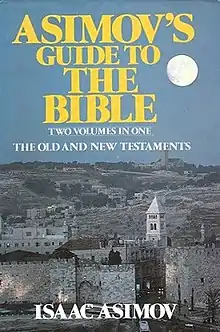
Asimov's Guide to the Bible is a work by Isaac Asimov that was first published in two volumes in 1968 and 1969,[1] covering the Old Testament and the New Testament (including the Catholic Old Testament, or deuterocanonical, books (see Catholic Bible) and the Eastern Orthodox Old Testament books, or anagignoskomena, along with the Fourth Book of Ezra), respectively. He combined them into a single 1296-page volume in 1981.[1] They included maps by the artist Rafael Palacios.
Including numerous black-and-white maps, the guide goes through the books of the Bible in the order of the King James Version to the extent possible, explaining the historical and geographical setting of each one, and the political and historical influences that affected it, as well as biographical information about the main characters. His appendix "Guides to the Old and New Testament" includes biblical verses, footnotes, references and subject indices.
The book was written for the layperson, without expectation that the reader would have much knowledge about ancient history.[1]
The Guide has been the subject of scholarly criticism. Professor Robert C. Dentan reminded readers that Asimov's book was not an academic work and he overlooked advances in contemporary biblical archeology. He also noted it as having "lengthy discussions of insoluble geographical problems...The result often seems to emphasize the trivial at the expense of the substantive."[2]
References
- 1 2 3 Jones, Josh (2019-03-28). "Isaac Asimov's Guide to the Bible: A Witty, Erudite Atheist's Guide to the World's Most Famous Book". Open Culture. Retrieved 2020-08-24.
- ↑ Robert C. Dentan (November 17, 1968). "Including Uz and Buz". The New York Times. Retrieved January 1, 2022.
Publication data
- Asimov's Guide to the Bible: The Old and New Testaments, Wings Books (Random House), 1981, ISBN 0-517-34582-X, also Gramercy Press reprint 1988 (same ISBN)
External links
- Brummond, Michael. "Religion in Asimov's Writings". Retrieved 26 December 2013.
- Isaac Asimov FAQ